Gongyang Li
Context-Aware Interaction Network for RGB-T Semantic Segmentation
Jan 03, 2024



Abstract:RGB-T semantic segmentation is a key technique for autonomous driving scenes understanding. For the existing RGB-T semantic segmentation methods, however, the effective exploration of the complementary relationship between different modalities is not implemented in the information interaction between multiple levels. To address such an issue, the Context-Aware Interaction Network (CAINet) is proposed for RGB-T semantic segmentation, which constructs interaction space to exploit auxiliary tasks and global context for explicitly guided learning. Specifically, we propose a Context-Aware Complementary Reasoning (CACR) module aimed at establishing the complementary relationship between multimodal features with the long-term context in both spatial and channel dimensions. Further, considering the importance of global contextual and detailed information, we propose the Global Context Modeling (GCM) module and Detail Aggregation (DA) module, and we introduce specific auxiliary supervision to explicitly guide the context interaction and refine the segmentation map. Extensive experiments on two benchmark datasets of MFNet and PST900 demonstrate that the proposed CAINet achieves state-of-the-art performance. The code is available at https://github.com/YingLv1106/CAINet.
Texture-Semantic Collaboration Network for ORSI Salient Object Detection
Dec 06, 2023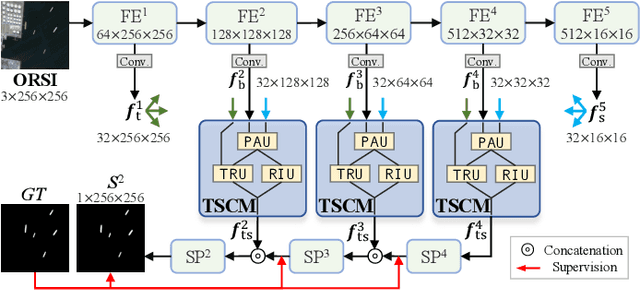
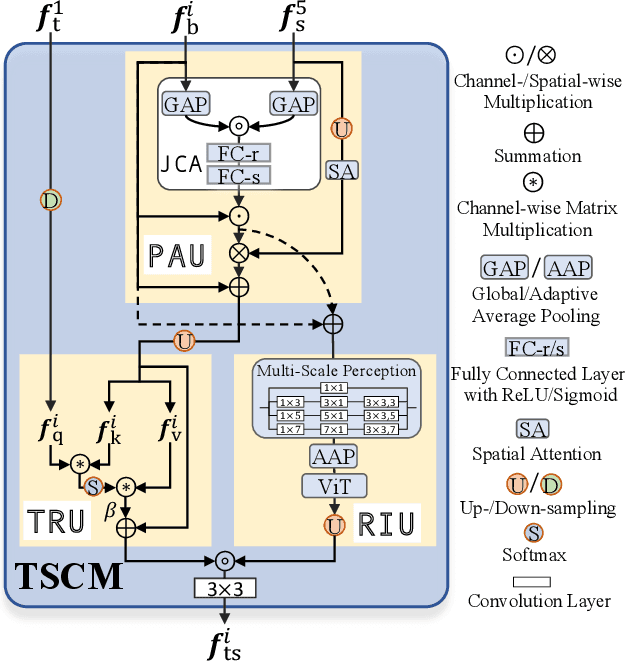
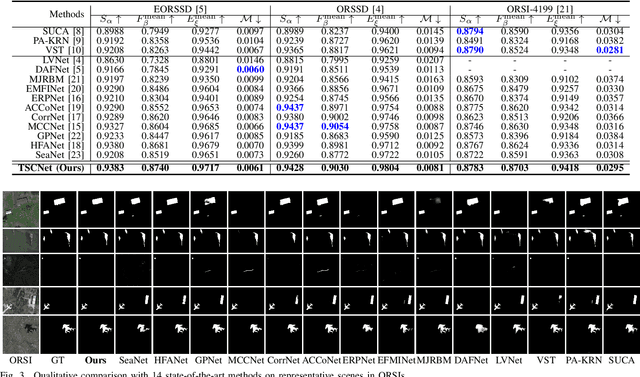

Abstract:Salient object detection (SOD) in optical remote sensing images (ORSIs) has become increasingly popular recently. Due to the characteristics of ORSIs, ORSI-SOD is full of challenges, such as multiple objects, small objects, low illuminations, and irregular shapes. To address these challenges, we propose a concise yet effective Texture-Semantic Collaboration Network (TSCNet) to explore the collaboration of texture cues and semantic cues for ORSI-SOD. Specifically, TSCNet is based on the generic encoder-decoder structure. In addition to the encoder and decoder, TSCNet includes a vital Texture-Semantic Collaboration Module (TSCM), which performs valuable feature modulation and interaction on basic features extracted from the encoder. The main idea of our TSCM is to make full use of the texture features at the lowest level and the semantic features at the highest level to achieve the expression enhancement of salient regions on features. In the TSCM, we first enhance the position of potential salient regions using semantic features. Then, we render and restore the object details using the texture features. Meanwhile, we also perceive regions of various scales, and construct interactions between different regions. Thanks to the perfect combination of TSCM and generic structure, our TSCNet can take care of both the position and details of salient objects, effectively handling various scenes. Extensive experiments on three datasets demonstrate that our TSCNet achieves competitive performance compared to 14 state-of-the-art methods. The code and results of our method are available at https://github.com/MathLee/TSCNet.
Salient Object Detection in Optical Remote Sensing Images Driven by Transformer
Sep 15, 2023



Abstract:Existing methods for Salient Object Detection in Optical Remote Sensing Images (ORSI-SOD) mainly adopt Convolutional Neural Networks (CNNs) as the backbone, such as VGG and ResNet. Since CNNs can only extract features within certain receptive fields, most ORSI-SOD methods generally follow the local-to-contextual paradigm. In this paper, we propose a novel Global Extraction Local Exploration Network (GeleNet) for ORSI-SOD following the global-to-local paradigm. Specifically, GeleNet first adopts a transformer backbone to generate four-level feature embeddings with global long-range dependencies. Then, GeleNet employs a Direction-aware Shuffle Weighted Spatial Attention Module (D-SWSAM) and its simplified version (SWSAM) to enhance local interactions, and a Knowledge Transfer Module (KTM) to further enhance cross-level contextual interactions. D-SWSAM comprehensively perceives the orientation information in the lowest-level features through directional convolutions to adapt to various orientations of salient objects in ORSIs, and effectively enhances the details of salient objects with an improved attention mechanism. SWSAM discards the direction-aware part of D-SWSAM to focus on localizing salient objects in the highest-level features. KTM models the contextual correlation knowledge of two middle-level features of different scales based on the self-attention mechanism, and transfers the knowledge to the raw features to generate more discriminative features. Finally, a saliency predictor is used to generate the saliency map based on the outputs of the above three modules. Extensive experiments on three public datasets demonstrate that the proposed GeleNet outperforms relevant state-of-the-art methods. The code and results of our method are available at https://github.com/MathLee/GeleNet.
No-Service Rail Surface Defect Segmentation via Normalized Attention and Dual-scale Interaction
Jun 27, 2023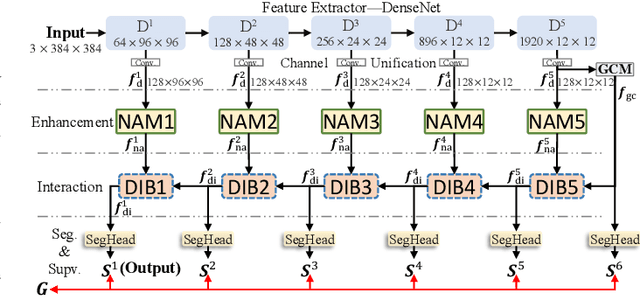
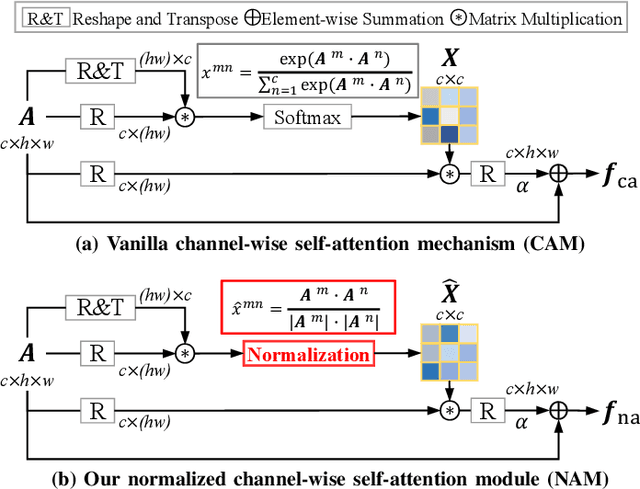
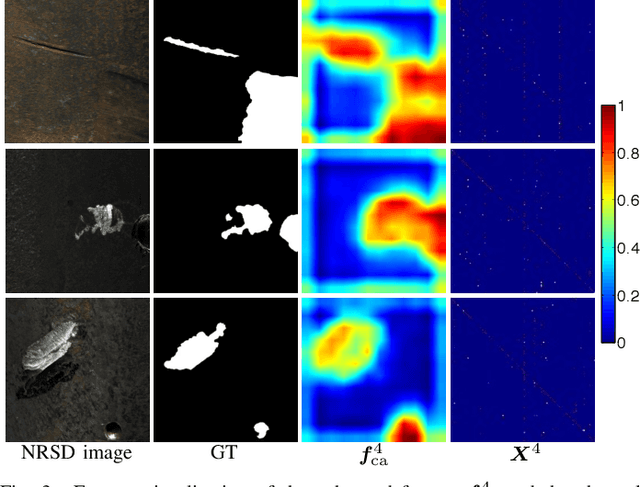
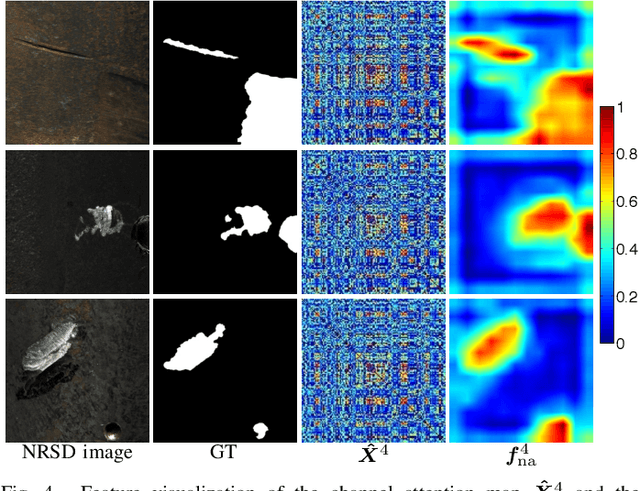
Abstract:No-service rail surface defect (NRSD) segmentation is an essential way for perceiving the quality of no-service rails. However, due to the complex and diverse outlines and low-contrast textures of no-service rails, existing natural image segmentation methods cannot achieve promising performance in NRSD images, especially in some unique and challenging NRSD scenes. To this end, in this paper, we propose a novel segmentation network for NRSDs based on Normalized Attention and Dual-scale Interaction, named NaDiNet. Specifically, NaDiNet follows the enhancement-interaction paradigm. The Normalized Channel-wise Self-Attention Module (NAM) and the Dual-scale Interaction Block (DIB) are two key components of NaDiNet. NAM is a specific extension of the channel-wise self-attention mechanism (CAM) to enhance features extracted from low-contrast NRSD images. The softmax layer in CAM will produce very small correlation coefficients which are not conducive to low-contrast feature enhancement. Instead, in NAM, we directly calculate the normalized correlation coefficient between channels to enlarge the feature differentiation. DIB is specifically designed for the feature interaction of the enhanced features. It has two interaction branches with dual scales, one for fine-grained clues and the other for coarse-grained clues. With both branches working together, DIB can perceive defect regions of different granularities. With these modules working together, our NaDiNet can generate accurate segmentation map. Extensive experiments on the public NRSD-MN dataset with man-made and natural NRSDs demonstrate that our proposed NaDiNet with various backbones (i.e., VGG, ResNet, and DenseNet) consistently outperforms 10 state-of-the-art methods. The code and results of our method are available at https://github.com/monxxcn/NaDiNet.
Lightweight Salient Object Detection in Optical Remote Sensing Images via Semantic Matching and Edge Alignment
Jan 07, 2023



Abstract:Recently, relying on convolutional neural networks (CNNs), many methods for salient object detection in optical remote sensing images (ORSI-SOD) are proposed. However, most methods ignore the huge parameters and computational cost brought by CNNs, and only a few pay attention to the portability and mobility. To facilitate practical applications, in this paper, we propose a novel lightweight network for ORSI-SOD based on semantic matching and edge alignment, termed SeaNet. Specifically, SeaNet includes a lightweight MobileNet-V2 for feature extraction, a dynamic semantic matching module (DSMM) for high-level features, an edge self-alignment module (ESAM) for low-level features, and a portable decoder for inference. First, the high-level features are compressed into semantic kernels. Then, semantic kernels are used to activate salient object locations in two groups of high-level features through dynamic convolution operations in DSMM. Meanwhile, in ESAM, cross-scale edge information extracted from two groups of low-level features is self-aligned through L2 loss and used for detail enhancement. Finally, starting from the highest-level features, the decoder infers salient objects based on the accurate locations and fine details contained in the outputs of the two modules. Extensive experiments on two public datasets demonstrate that our lightweight SeaNet not only outperforms most state-of-the-art lightweight methods but also yields comparable accuracy with state-of-the-art conventional methods, while having only 2.76M parameters and running with 1.7G FLOPs for 288x288 inputs. Our code and results are available at https://github.com/MathLee/SeaNet.
RGB-T Semantic Segmentation with Location, Activation, and Sharpening
Oct 26, 2022Abstract:Semantic segmentation is important for scene understanding. To address the scenes of adverse illumination conditions of natural images, thermal infrared (TIR) images are introduced. Most existing RGB-T semantic segmentation methods follow three cross-modal fusion paradigms, i.e. encoder fusion, decoder fusion, and feature fusion. Some methods, unfortunately, ignore the properties of RGB and TIR features or the properties of features at different levels. In this paper, we propose a novel feature fusion-based network for RGB-T semantic segmentation, named \emph{LASNet}, which follows three steps of location, activation, and sharpening. The highlight of LASNet is that we fully consider the characteristics of cross-modal features at different levels, and accordingly propose three specific modules for better segmentation. Concretely, we propose a Collaborative Location Module (CLM) for high-level semantic features, aiming to locate all potential objects. We propose a Complementary Activation Module for middle-level features, aiming to activate exact regions of different objects. We propose an Edge Sharpening Module (ESM) for low-level texture features, aiming to sharpen the edges of objects. Furthermore, in the training phase, we attach a location supervision and an edge supervision after CLM and ESM, respectively, and impose two semantic supervisions in the decoder part to facilitate network convergence. Experimental results on two public datasets demonstrate that the superiority of our LASNet over relevant state-of-the-art methods. The code and results of our method are available at https://github.com/MathLee/LASNet.
Adjacent Context Coordination Network for Salient Object Detection in Optical Remote Sensing Images
Mar 25, 2022



Abstract:Salient object detection (SOD) in optical remote sensing images (RSIs), or RSI-SOD, is an emerging topic in understanding optical RSIs. However, due to the difference between optical RSIs and natural scene images (NSIs), directly applying NSI-SOD methods to optical RSIs fails to achieve satisfactory results. In this paper, we propose a novel Adjacent Context Coordination Network (ACCoNet) to explore the coordination of adjacent features in an encoder-decoder architecture for RSI-SOD. Specifically, ACCoNet consists of three parts: an encoder, Adjacent Context Coordination Modules (ACCoMs), and a decoder. As the key component of ACCoNet, ACCoM activates the salient regions of output features of the encoder and transmits them to the decoder. ACCoM contains a local branch and two adjacent branches to coordinate the multi-level features simultaneously. The local branch highlights the salient regions in an adaptive way, while the adjacent branches introduce global information of adjacent levels to enhance salient regions. Additionally, to extend the capabilities of the classic decoder block (i.e., several cascaded convolutional layers), we extend it with two bifurcations and propose a Bifurcation-Aggregation Block to capture the contextual information in the decoder. Extensive experiments on two benchmark datasets demonstrate that the proposed ACCoNet outperforms 22 state-of-the-art methods under nine evaluation metrics, and runs up to 81 fps on a single NVIDIA Titan X GPU. The code and results of our method are available at https://github.com/MathLee/ACCoNet.
Lightweight Salient Object Detection in Optical Remote Sensing Images via Feature Correlation
Jan 20, 2022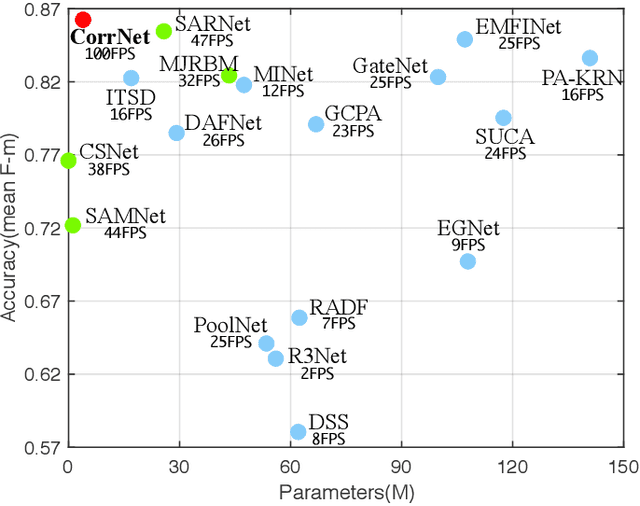


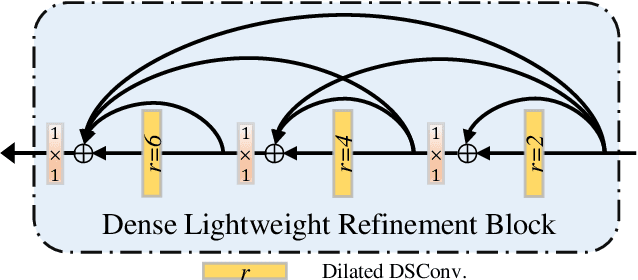
Abstract:Salient object detection in optical remote sensing images (ORSI-SOD) has been widely explored for understanding ORSIs. However, previous methods focus mainly on improving the detection accuracy while neglecting the cost in memory and computation, which may hinder their real-world applications. In this paper, we propose a novel lightweight ORSI-SOD solution, named CorrNet, to address these issues. In CorrNet, we first lighten the backbone (VGG-16) and build a lightweight subnet for feature extraction. Then, following the coarse-to-fine strategy, we generate an initial coarse saliency map from high-level semantic features in a Correlation Module (CorrM). The coarse saliency map serves as the location guidance for low-level features. In CorrM, we mine the object location information between high-level semantic features through the cross-layer correlation operation. Finally, based on low-level detailed features, we refine the coarse saliency map in the refinement subnet equipped with Dense Lightweight Refinement Blocks, and produce the final fine saliency map. By reducing the parameters and computations of each component, CorrNet ends up having only 4.09M parameters and running with 21.09G FLOPs. Experimental results on two public datasets demonstrate that our lightweight CorrNet achieves competitive or even better performance compared with 26 state-of-the-art methods (including 16 large CNN-based methods and 2 lightweight methods), and meanwhile enjoys the clear memory and run time efficiency. The code and results of our method are available at https://github.com/MathLee/CorrNet.
Multi-Content Complementation Network for Salient Object Detection in Optical Remote Sensing Images
Dec 02, 2021



Abstract:In the computer vision community, great progresses have been achieved in salient object detection from natural scene images (NSI-SOD); by contrast, salient object detection in optical remote sensing images (RSI-SOD) remains to be a challenging emerging topic. The unique characteristics of optical RSIs, such as scales, illuminations and imaging orientations, bring significant differences between NSI-SOD and RSI-SOD. In this paper, we propose a novel Multi-Content Complementation Network (MCCNet) to explore the complementarity of multiple content for RSI-SOD. Specifically, MCCNet is based on the general encoder-decoder architecture, and contains a novel key component named Multi-Content Complementation Module (MCCM), which bridges the encoder and the decoder. In MCCM, we consider multiple types of features that are critical to RSI-SOD, including foreground features, edge features, background features, and global image-level features, and exploit the content complementarity between them to highlight salient regions over various scales in RSI features through the attention mechanism. Besides, we comprehensively introduce pixel-level, map-level and metric-aware losses in the training phase. Extensive experiments on two popular datasets demonstrate that the proposed MCCNet outperforms 23 state-of-the-art methods, including both NSI-SOD and RSI-SOD methods. The code and results of our method are available at https://github.com/MathLee/MCCNet.
Spatio-Temporal Self-Attention Network for Video Saliency Prediction
Aug 24, 2021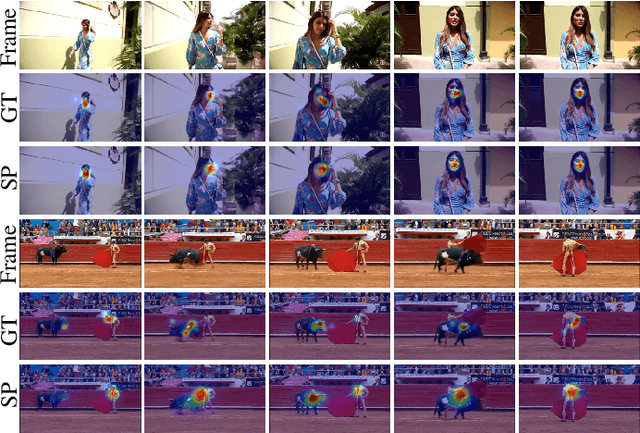
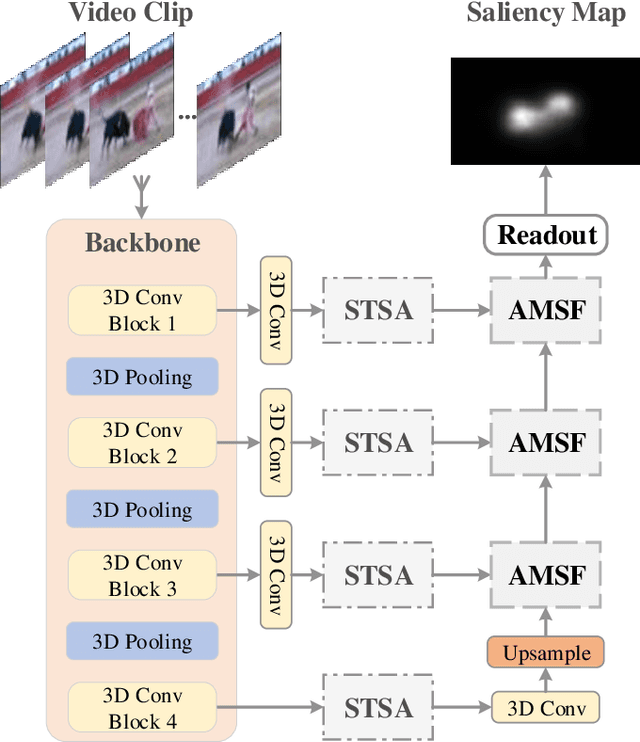
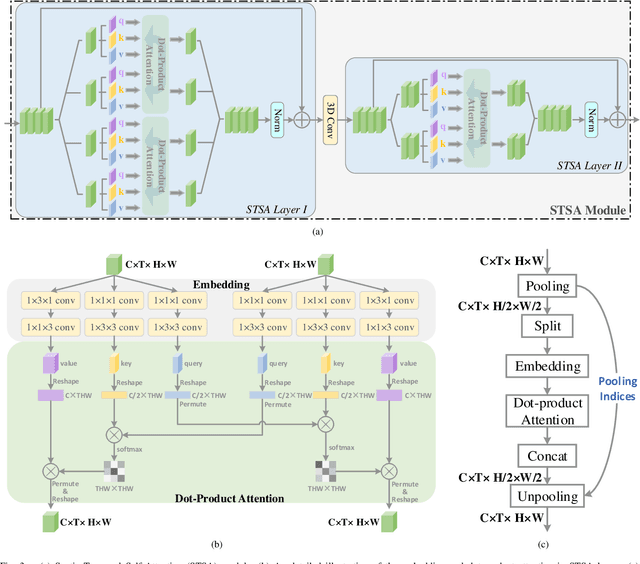
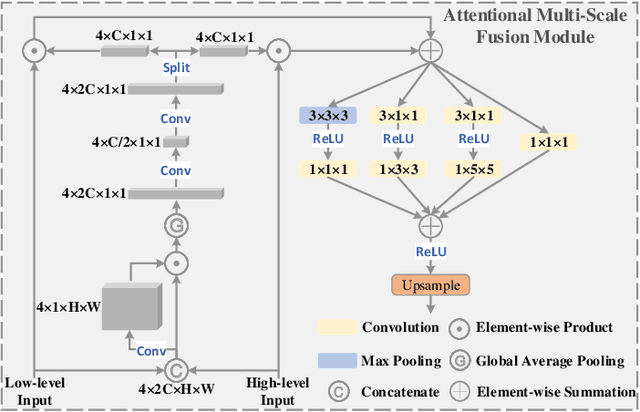
Abstract:3D convolutional neural networks have achieved promising results for video tasks in computer vision, including video saliency prediction that is explored in this paper. However, 3D convolution encodes visual representation merely on fixed local spacetime according to its kernel size, while human attention is always attracted by relational visual features at different time of a video. To overcome this limitation, we propose a novel Spatio-Temporal Self-Attention 3D Network (STSANet) for video saliency prediction, in which multiple Spatio-Temporal Self-Attention (STSA) modules are employed at different levels of 3D convolutional backbone to directly capture long-range relations between spatio-temporal features of different time steps. Besides, we propose an Attentional Multi-Scale Fusion (AMSF) module to integrate multi-level features with the perception of context in semantic and spatio-temporal subspaces. Extensive experiments demonstrate the contributions of key components of our method, and the results on DHF1K, Hollywood-2, UCF, and DIEM benchmark datasets clearly prove the superiority of the proposed model compared with all state-of-the-art models.
 Add to Chrome
Add to Chrome Add to Firefox
Add to Firefox Add to Edge
Add to Edge